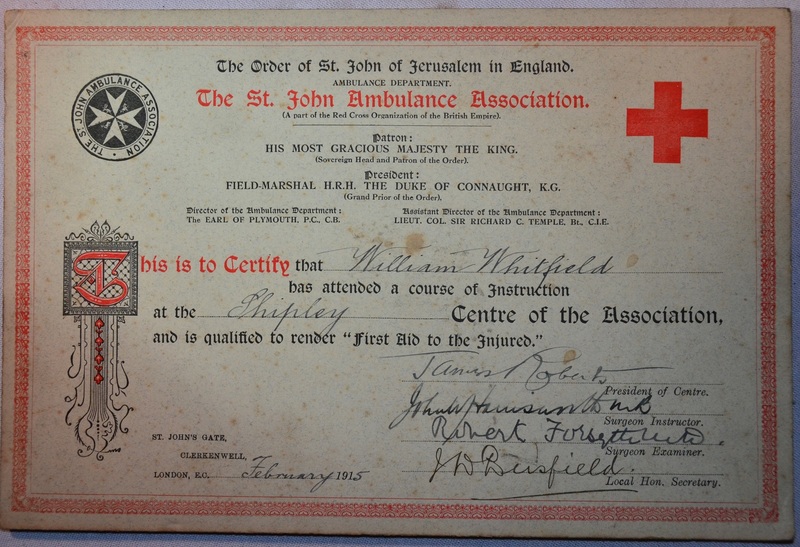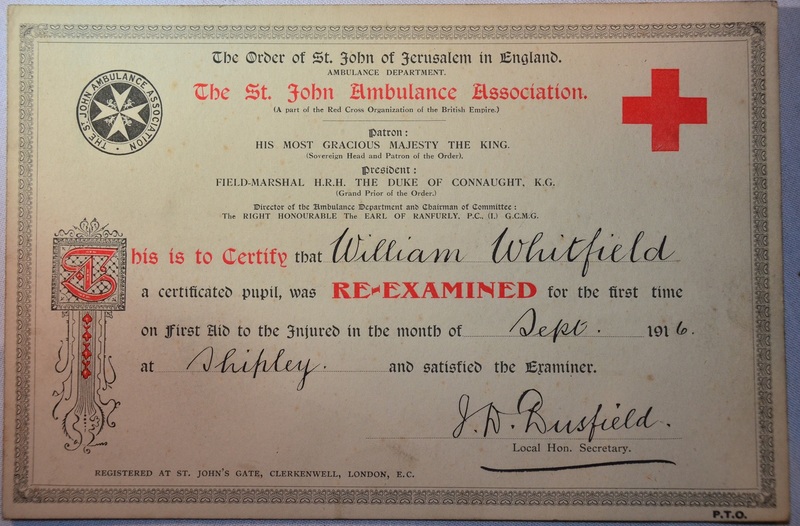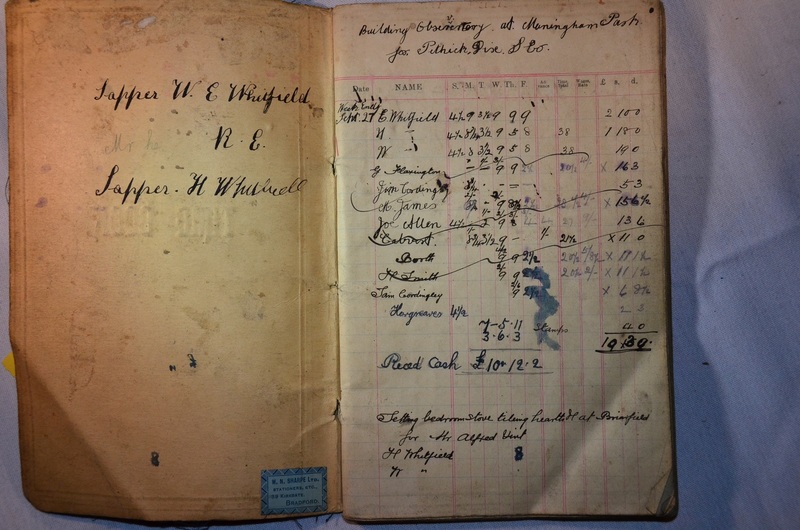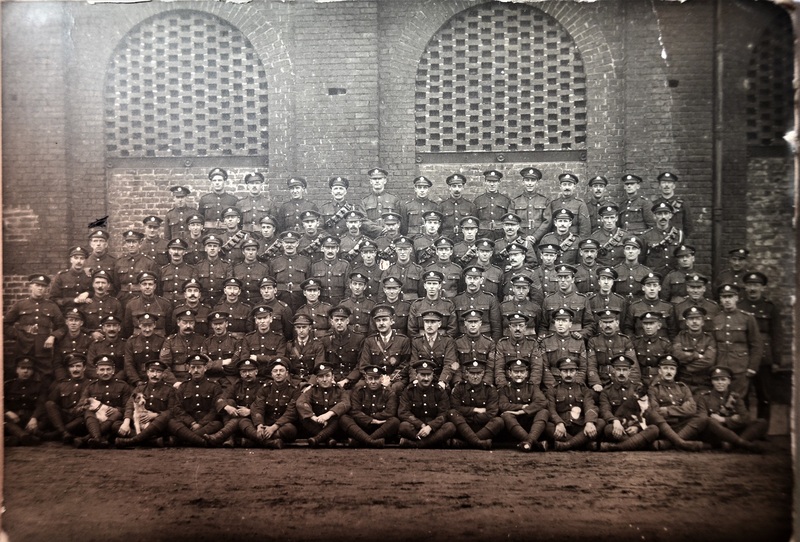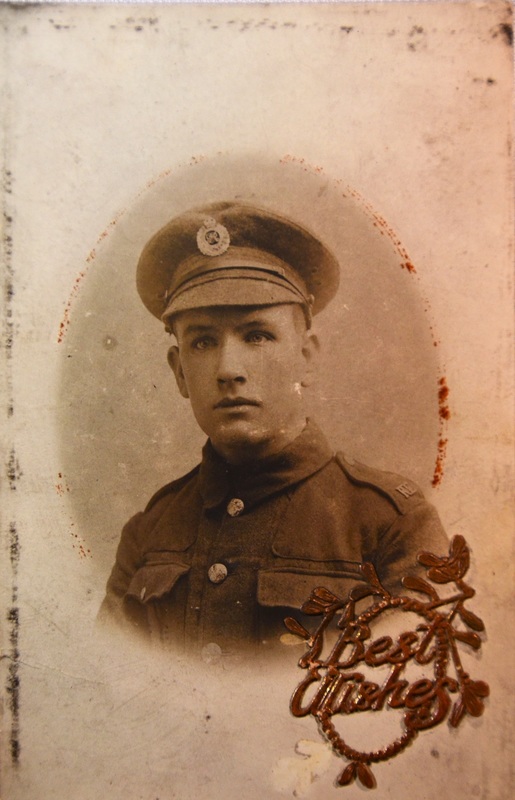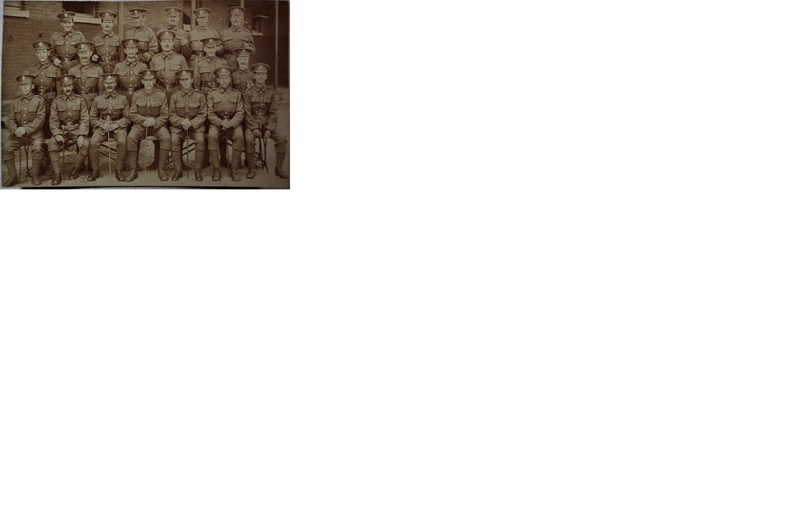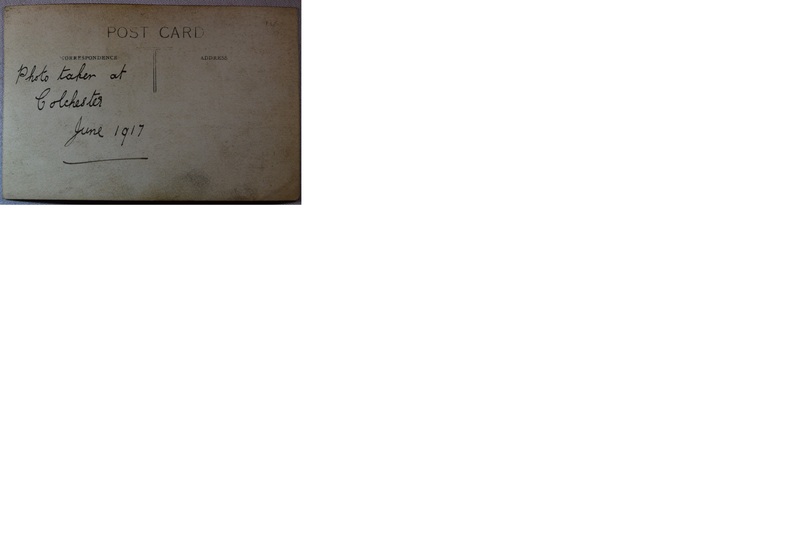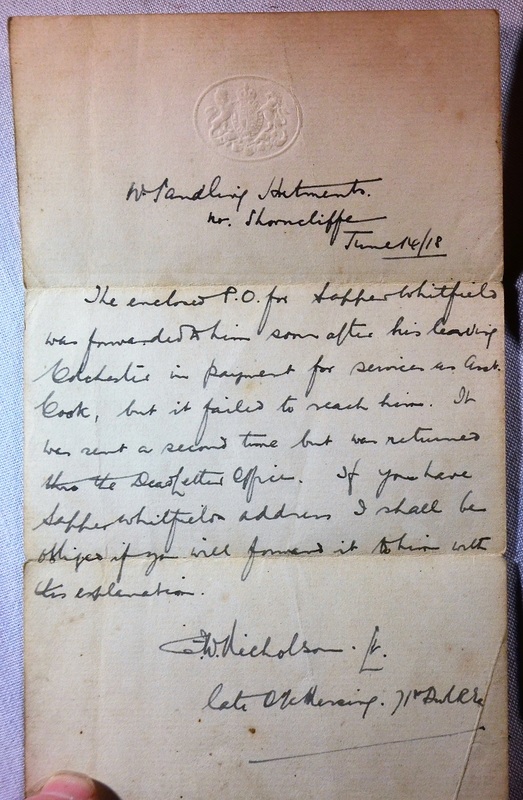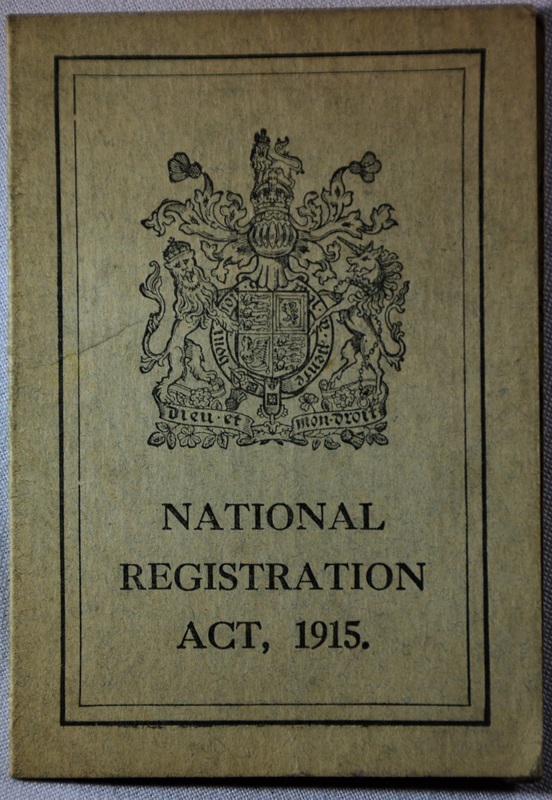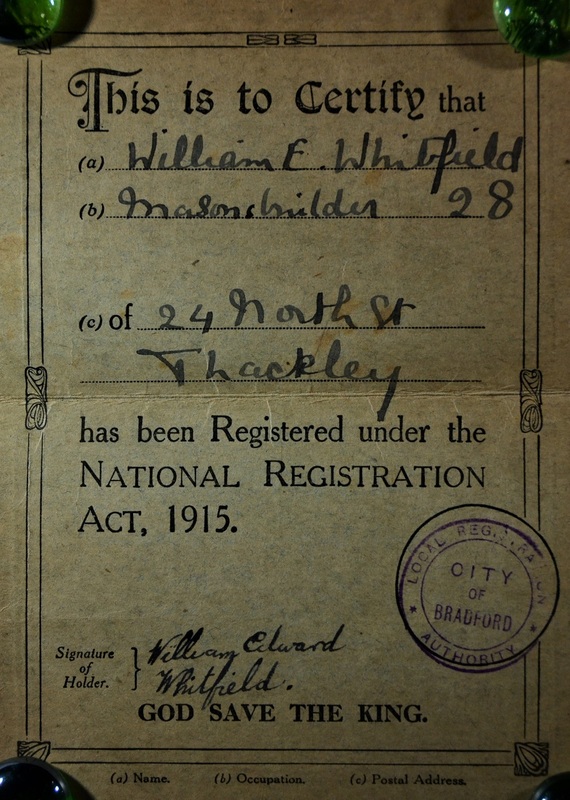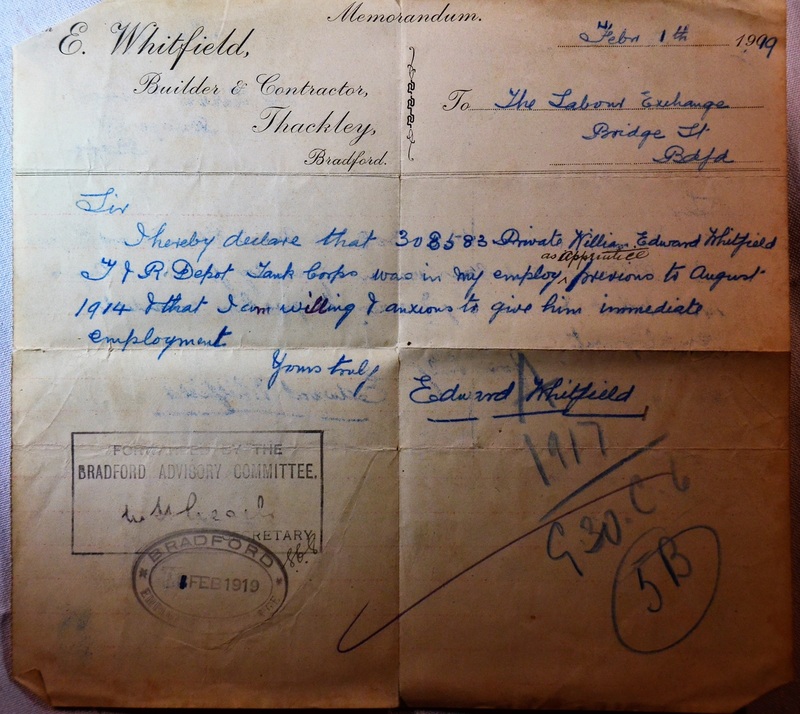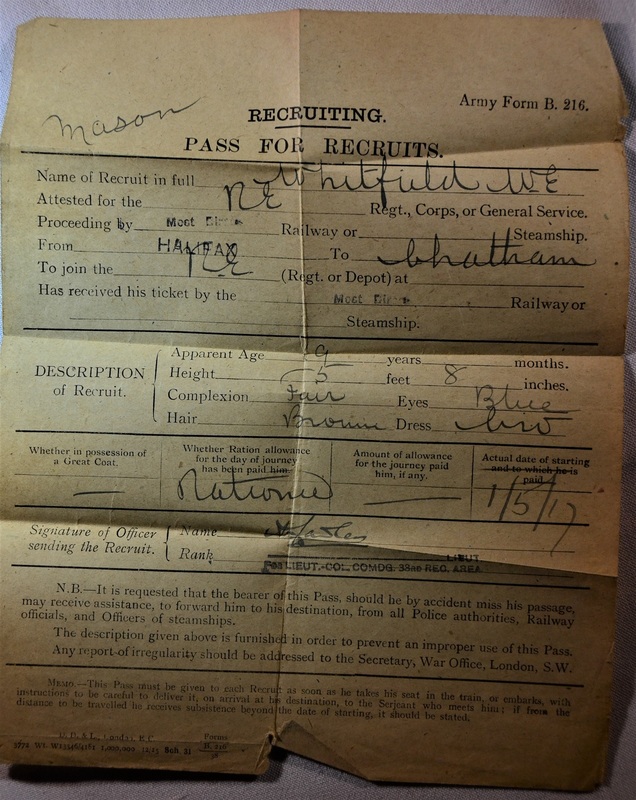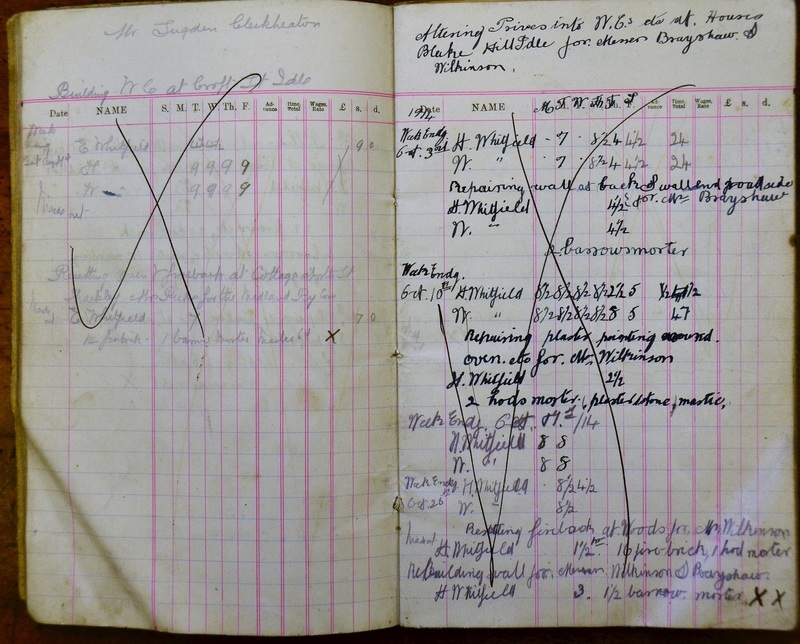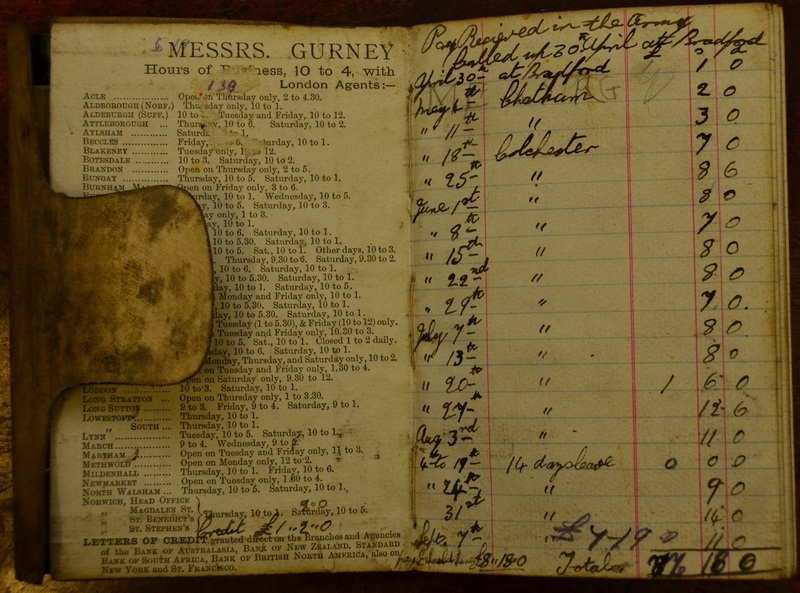3 Thackley brothers - the Whitfields part 3
Item
Title
3 Thackley brothers - the Whitfields part 3
Who?
William Edward (Bill) Whitfield (1) before call up (2) in the Royal Engineers
Item(s)
Documents, photos
Story
William Edward Whitfield was born on 13th February 1898 and baptized at Idle Primitive Methodist Chapel. In 1911 (census) aged 13 he was attending school part-time and also working as a factory hand for a woollen manufacturer. Before long he trained as a mason and worked for his father who later confirmed in a letter to the Bradford Employment Exchange that Bill was in his employ ‘as Apprentice previous to August 1914.’ The family building company Job and Wage Book details the sorts of general building work the Whitfields were undertaking. The first page lists wages for building an Observatory in Manningham Park, but other jobs were much smaller, such as asphalting paths and resetting stoves. The page which covers the outbreak of war over the Bank Holiday weekend at the start of August 1914 illustrates the dislocation this caused to the economy. The last entry in peacetime was for the week ending Saturday 1st August, for ‘Building W.C. at Croft St. Idle’. The next entry was not until the week ending 3rd October. This suggests that for 2 months the company undertook no work. Furthermore, the jobs recorded for the first 3 weeks of October seem to have engaged only 2 men; ‘H’ and ‘W’ must indicate the brothers Hubert and William. However, work then picked up and the Whitfields resumed work on the same sorts of jobs as before the war.
Bill was nearly 16 ½ years old when the war began, not yet old enough to serve. The family story is that Bill signed up when he was 16; this is contradicted by the documents and his Service Record which fortunately survives among the ‘Burnt Records’. Soon after the outbreak he began to attend a St. John’s Ambulance Association course in Shipley ‘to render “First Aid to the Injured”’. We do not know when he took the examination but it would seem he did not pass for in September 1916 he was re-examined and this time he succeeded. By this time the government had passed the National Registration Act on 15 July 1915 as a step towards stimulating recruitment and to discover how many men between the ages of 15 and 65 were engaged in each trade. All those in this age range who were not already in the military were obliged to register, giving details of their employment details. Bill’s registration card shows he was assigned to ‘Class 28’. This measure was followed by Lord Derby’s ‘Group Scheme’ which as an attempt to persuade more men to join the armed forces was a disappointment. Consequently the Military Service Act of 27th January 1916 deemed all men between 18 and 41 on Thursday 2nd March of the same year to have enlisted for general service with the colours or in the reserve. Bill was 18 in February 1916 and so the provisions of the Act applied to him. He was conscripted on 2nd March and transferred to the reserve until he was called up. From Bill’s Service Record and other documents a detailed account of his movements and service can be compiled. Men of Class 1 (that is, 18 year olds), once enrolled, were given the option of returning home or remaining with the Colours and undergoing special training until they were 19. Bill chose the former option to await the day he received notice of his call up - on 30th April 1917 he reported to the recruiting office in Bradford where his details were entered into Form 2513. He was sent to Halifax where he was posted to the Royal Engineers and on 1st May he was given a rail warrant for Chatham, the Corps’ depot.
When he was called up Bill was aged 19 years and 176 days. His Record of Service (Form 2513) shows his occupation as ‘Mason and Horse man’ and he requested to be posted to the Royal Army Medical Corps – there is a clear link between this and his courses in first aid for the injured. This preference was ignored and he was instead directed to the Royal Engineers. He was classified category Bi and his form was stamped ‘Garrison Service Abroad.’ The next page described him as 5’ 8” in height and his chest measurement was 32½-35”. After two weeks at Chatham he was posted to Colchester where for more than a year he trained with 549th Lancashire Field Company R.E. Although most photos are not labelled, it is likely that those here date from this period. The letter shows that for some of his time at Colchester he was employed as Assistant Cook for which duties he received extra pay. On 1st November 1917 his medical classification was upgraded to category ‘A’. While the entries on the ‘Statement of Services’ page in Bill’s Service Record are sometimes illegible, his army service can be elucidated by the meticulous record of his pay that he kept in the account book which is in the collection. The first page records his call up in Bradford on 30th April 1917, the initial posting to the Depot at Chatham, and a fortnight later his transfer to Colchester. He was a Sapper in the Royal Engineers. In August he was allowed 14 days leave. The next page records that from 5th October he received an extra payment of 3/6d, which may have been for his duties as assistant cook referred to in the letter. In the first week of January 1918 he had another leave of 5 days, and then he was transferred to the R.E. Training Centre, Deganwy (Conway) in North Wales. This transfer followed Bill’s reclassification as Category ‘A’.
Bill was nearly 16 ½ years old when the war began, not yet old enough to serve. The family story is that Bill signed up when he was 16; this is contradicted by the documents and his Service Record which fortunately survives among the ‘Burnt Records’. Soon after the outbreak he began to attend a St. John’s Ambulance Association course in Shipley ‘to render “First Aid to the Injured”’. We do not know when he took the examination but it would seem he did not pass for in September 1916 he was re-examined and this time he succeeded. By this time the government had passed the National Registration Act on 15 July 1915 as a step towards stimulating recruitment and to discover how many men between the ages of 15 and 65 were engaged in each trade. All those in this age range who were not already in the military were obliged to register, giving details of their employment details. Bill’s registration card shows he was assigned to ‘Class 28’. This measure was followed by Lord Derby’s ‘Group Scheme’ which as an attempt to persuade more men to join the armed forces was a disappointment. Consequently the Military Service Act of 27th January 1916 deemed all men between 18 and 41 on Thursday 2nd March of the same year to have enlisted for general service with the colours or in the reserve. Bill was 18 in February 1916 and so the provisions of the Act applied to him. He was conscripted on 2nd March and transferred to the reserve until he was called up. From Bill’s Service Record and other documents a detailed account of his movements and service can be compiled. Men of Class 1 (that is, 18 year olds), once enrolled, were given the option of returning home or remaining with the Colours and undergoing special training until they were 19. Bill chose the former option to await the day he received notice of his call up - on 30th April 1917 he reported to the recruiting office in Bradford where his details were entered into Form 2513. He was sent to Halifax where he was posted to the Royal Engineers and on 1st May he was given a rail warrant for Chatham, the Corps’ depot.
When he was called up Bill was aged 19 years and 176 days. His Record of Service (Form 2513) shows his occupation as ‘Mason and Horse man’ and he requested to be posted to the Royal Army Medical Corps – there is a clear link between this and his courses in first aid for the injured. This preference was ignored and he was instead directed to the Royal Engineers. He was classified category Bi and his form was stamped ‘Garrison Service Abroad.’ The next page described him as 5’ 8” in height and his chest measurement was 32½-35”. After two weeks at Chatham he was posted to Colchester where for more than a year he trained with 549th Lancashire Field Company R.E. Although most photos are not labelled, it is likely that those here date from this period. The letter shows that for some of his time at Colchester he was employed as Assistant Cook for which duties he received extra pay. On 1st November 1917 his medical classification was upgraded to category ‘A’. While the entries on the ‘Statement of Services’ page in Bill’s Service Record are sometimes illegible, his army service can be elucidated by the meticulous record of his pay that he kept in the account book which is in the collection. The first page records his call up in Bradford on 30th April 1917, the initial posting to the Depot at Chatham, and a fortnight later his transfer to Colchester. He was a Sapper in the Royal Engineers. In August he was allowed 14 days leave. The next page records that from 5th October he received an extra payment of 3/6d, which may have been for his duties as assistant cook referred to in the letter. In the first week of January 1918 he had another leave of 5 days, and then he was transferred to the R.E. Training Centre, Deganwy (Conway) in North Wales. This transfer followed Bill’s reclassification as Category ‘A’.
When?
Britain
Where?
1914-1918
Contributor
Liz Hall
Collection Day
City Hall, Bradford (2/2/2019)
This item was submitted on March 14, 2019

